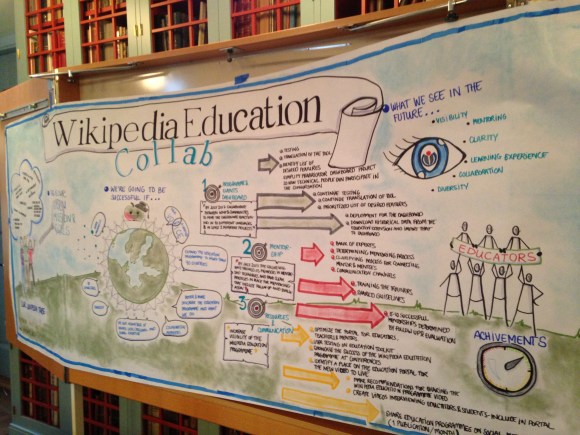
Some time back, when she got behind the scenes and started editing Wikipedia, Sara Mörstell asked herself: “How can use this with my students?” Some years later, and after gaining experience running her own Wikimedia Education Program, Sara found herself co-organizing the Wikipedia Education Collaborative’s (“Collab”) third meeting, in Sweden. The Collab is a global network of education program leaders created in 2014 to support the development of education programs around the globe, and members like Sara volunteer to mentor other educators who are interested in using Wikipedia as a teaching tool, as well as Wikimedians interested in running education programs. Over the weekend of March 5–6, program leaders that form the Collab gathered in Stockholm to define common goals, priorities and projects for the group to focus on over the next year.
What is the engine that moves the Collab forward? Some of the guiding principles of the Collab are building networks, sharing experiences and fostering collaboration across education programs, organizations, volunteers and geographies throughout the movement. It’s about sharing our experience and expertise with our peers to support other programs at a global scale.
Some of the founding goals defined for the collab were to establish best practices for Wikipedia in education programs, collect new ideas for educational initiatives, share resources between global programs, develop a global recognition system, communicate effectively about experiences, tools and resources. Some of the goals have already been accomplished, like the new recognition system: the collab developed templates and general guidelines as a way to offer certificates to students and teachers participation in different initiatives. Another goal that we accomplished is the creation and translation of many educational resources, like a guide on how to evaluate article quality on Wikipedia, a guide to free licenses, the education program toolkit, and many other resources classified in four categories for specific audiences: for program leaders, for educators, for volunteers and for students. Communication and documentation remains a priority for our group in the coming year.
Last year, the scope and model of the Collab was redefined as a strategic group to support the development of education programs around the world. During 2015, the Collab achieved some key milestones that now give way to imagine the next steps of this group of practice. One example is clearer and simpler membership criteria. As a result, 10 new program leaders joined for a total of 23 collab members, most of whom are women. Another important change was that the decisions about the Collab are managed collaboratively by the group. The listserv (mailing list) was opened to the public so the discussion was available for everyone. We started to use Phabricator as a central platform to define and coordinate tasks. During this time, we accomplished 88 tasks together, 22% of which were one-on-one mentoring support to other global programs. Other milestones include monthly video calls to promote interaction and exchange among the Collab members, and offline engagement at Wikimania 2015, where of many Collab members participated in the education pre-conference , as well as sitting on thematic panels and delivering individual presentations.
The Stockholm meeting was very significant because it gave us a chance to imagine the future of our group and decide how to take the Education Collaborative to the next level. In a very inspiring place and a warm atmosphere—in spite the cold weather— we welcomed new members, we talked about our concerns, our expectations and chalked out our vision for the future.
During the meeting, collab members had the opportunity to talk about how to scale education programs, share their experiences, and to set their personal and group goals. Some of the personal goals include to work on the mentoring process, create and translate resources (evaluation forms for educational activities, brochures and guides), work on enhancing visibility and communication of the education programs, test and translate the dashboard, to increase the reach of the Wikimedia Education Program and involve new participants, review and curate the existing learning patterns, among many others.
Our plan for the next year involves the design of a flexible mentoring roadmap; the development of resources, the improvement of the communication strategy; and testing and translating the Program and Events Dashboard, a new platform which will facilitate the work of educators and the organization of programs using Wikipedia in the classroom.
We left Stockholm with a sense of identity and belonging. Aware of our strengths and weaknesses, we feel that we have a lot of energy and motivation to boost the collab and to support the development of the education programs around the world.
Melina Masnatta, Education Manager, Wikimedia Argentina
Paola Ricaurte, Education Program Mexico
Special thanks go to Tighe Flanagan, Senior Manager, Wikipedia Education Program; María Cruz, Communications and Outreach Coordinator, Learning and Evaluation team, Wikimedia Foundation; and Subhashish Panigrahi, Communications Contractor, Program Capacity & Learning, Wikimedia Foundation in the writing of this post.

Can you help us translate this article?
In order for this article to reach as many people as possible we would like your help. Can you translate this article to get the message out?
Start translation